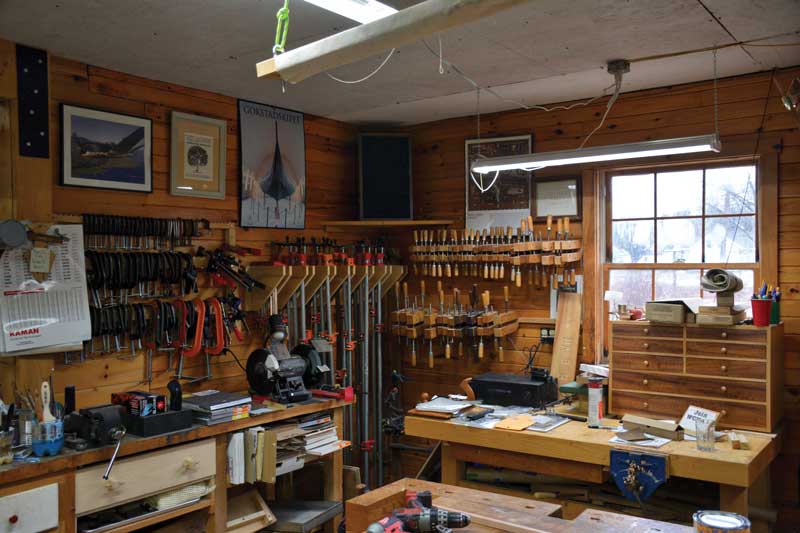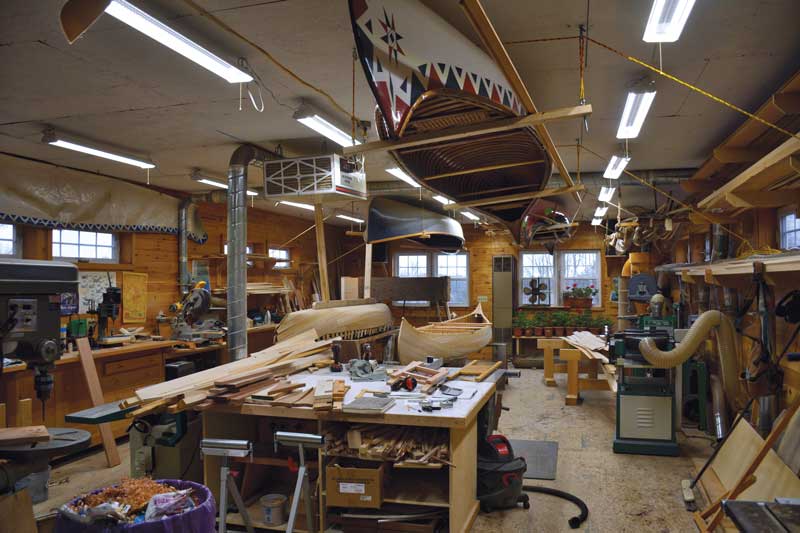Where Broken Canoes Find New Life
Bruce Larson of Georges River Canoe specializes in restoring classic canoes
By Roger Moody
Bruce Larson uses forms that he acquired from the estate of the late Burt Libby for his new canoe construction projects. The ribs and planking are fashioned from white and red cedar. Photo by Roger Moody
From the outside, the red workshop off Route 1 in Warren looks like many other utility barns. But instead of tractors, firewood, or livestock, this space is filled inside with classic canoes in various stages of restoration, original canoe forms made by one of Maine’s legendary craftsmen, and a vast inventory of specialized tools and materials for any imaginable repair (and some unimaginable ones, too).
Welcome to Bruce Larson’s Georges River Canoe workspace.
Larson’s passion began as a kid with his grandfather’s 1947 White Canoe Company canoe, and it peaked about 20 years ago when he attended canoe-master Jerry Stelmok’s wood-canvas canoe-building class at the WoodenBoat School in Brooklin, Maine. Since his retirement in 2017 from a career as a marine biologist and process engineer for DuPont’s carrageenan processing plant on Rockland’s waterfront, Larson’s addiction with canoes has reached nearly full-time status.
Larson, with help from his son Jeff, has taken up canoe building and restoration and he can’t get enough of it. “More canoes than brains,” he said of his passion for the watercraft. He acknowledged, though, that canoeing and fishing excursions on Maine rivers, lakes, and ponds will draw him away occasionally as he adjusts to his lifestyle as a recent retiree. “Wooden canoes and fly rods are quite compatible,” he mused.
His superbly equipped workshop and adjacent restored 1825 barn hold a dozen or more fully restored canoes, including some important historic designs. These include canoes designed and constructed by Old Town, White, Chestnut, Penn Yan, J.R. Robertson, H.B. Arnold, and others. A few classic freshwater rowing boats and square-stern motorboats from Old Town and White have a place here, too.
Larson builds “new” custom canoes as well, ranging from 12 to 18 feet, including 13-, 16- and 18-footers from forms that he was fortunate to acquire from the estate of the late Burt Libby (Burt’s Canoes). Larson also builds a 16-foot square-stern Old Town replica, which is a great fishing boat that cruises at 15 mph with a 6-hp outboard.

You can never have too many clamps, Larson said. Photo by Jeff Larson
Supplies of rough white and red cedar for planking and ribs, clear spruce for gunwales, and specialty woods such as cherry, walnut, and ash for outside gunwales, thwarts, seats, and decks are neatly stored, ready for milling and steam bending into needed components. There’s mahogany, too, for the rarer canoes in need of that species for the perfect, authentic restoration.
All the necessary tools of the trade, which range from an impressive array of clamps (Larson advised “you can never have too many”) to a variety of hand tools, are carefully organized for quick application to his work, along with a huge inventory of bronze fasteners.
Part of the fun of restoration, Larson said, is scrounging for the top-quality materials, some not easily found. “The cost of materials may seem expensive but with labor being the largest component of the cost of a restoration or new boat, it makes sense to use the best.”
Most of the hulls he restores need re-canvassing. First the old canvas is removed, repairs are made to any wood components, and the hull is varnished inside and out. Then the canvas is stretched and attached to the canoe. Canvas filler (a concoction of paint, silica, linseed oil, and other “stuff”) is applied to the canvas for waterproofing and filling the weave to provide a rock-hard smooth surface for painting. After the filler cures for four to six weeks, up to four coats of marine enamel are applied for the final finish.
Larson’s current projects include restorations of a 17-foot Chestnut “Prospector,” a 17-foot Kennebec guide model, and a Charles River style “courting canoe.” Over the years, his favorite restoration projects have been those that bring life back to a family’s heirloom boat, and those that meet the expectations of the client.
“It’s rewarding to rescue some of these classics from the burn pile,” he said.

Recent projects in Larson’s workshop included both old canoes in need of restoration and new boats under construction. Photo by Jeff Larson
No two restoration projects are alike, with each having their unique challenges. Many require repairs because of the way they have been stored—usually outside—or used, and sometimes abused. Most challenging is making wood bend where it doesn’t want to go and conform to the ever-changing curves on a canoe. Doing repairs and matching the patina of the original wood so the repair is not obvious can be particularly challenging, as well.
New building projects are also fun, Larson said, because the client gets to choose the canoe that best meets their paddling style or use (like tripping, fishing, and river or lake paddling) and the look (trim materials, finishes, etc.). Current new work includes building 13-foot and 16-foot canoes on the Burt Libby forms. Compared to other custom handcrafted wooden boats, wooden canoes can be quite affordable. Prices for a new canoe start at around $3,200 for a basic 13-foot model. Restorations start with re-canvassing at $100 per foot, with other repairs done on a labor and materials basis.
“I often get comments that these canoes are too beautiful to use, yet they are made to be used and with care can last for generations,” he said. “There is nothing like the beauty, look, and feel of a wood-canvas canoe on the water—quiet, resilient and alive, floating functional art.”
For wooden canoe enthusiasts Larson recommends the Wooden Canoe Heritage Association (wcha.org), an organization whose mission is to promote the use and preservation of wood canoes and the continuation of building skills and techniques. The WCHA Builders and Suppliers directory has contact information for building and restoration services and materials suppliers in Maine and throughout the country and is also an excellent resource for researching wood canoe history.
Roger Moody is a retired town manager, school business manager and county Commissioner who writes about boating history.
Georges River Canoe
27 Western Road, Warren, ME
207-542-0043; brlcanoe52@gmail.com
